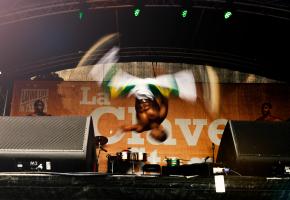Chino Soria's "Rama con cita" in the foreground at the Contagio exhibition.
The Gallery, Cecilia Brunson Projects (CPB), stands at the end of the Royal Oak Yard in Bermondsey. Bermondsey is an area that has been developing a user-friendly, artistic and warm environment, including pleasant restaurants and shops. It has become a very sought-after area in which to live. The gallery is another ingredient enhancing these elements. Founded in 2013, the objectives of the gallery have been to specialize in modern and contemporary Latin American Art. It has highlighted many important artists, including Alfredo Volpi, Coco Fusco, Waltercio Caldas and Willys de Castro. Last year it hosted the successful exhibition of the late Feliciano Centurión (see https://www.latinolife.co.uk/articles/‘i-am-awake’-1992-1996-paraguayan-artist-feliciano-centurión’s-exhibition-cecilia-brunson).
Cecilia Brunson has an interesting background in Latin American Art, having been associate curator of Latin American Art at the Blaton Museum in Austin, Texas and she was also the Latin American correspondent for Artforum, thus she is well placed to head this interesting gallery.
Cecilia Brunson: - “We felt it was the perfect opportunity to create a little bit of a community with these artists that have been living in this country for more than 10 years. Many have not had the chance to show with other of their peers in the UK, [even though] they already show their work in Latin America, participate in Art fairs and are very active in the Latin American Art scene. Some have been represented by local art galleries, some in Brazil and Venezuela, you know, everyone has a Gallery representation somewhere. There is a group that get together to read and discuss art every week and they are at the core of the exhibition and then they decided to bring in some other friends. Our space is small, so we could only accommodate a limited number. We selected artists from Ecuador, Uruguay, Peru, Chile, Venezuela and Argentina.”
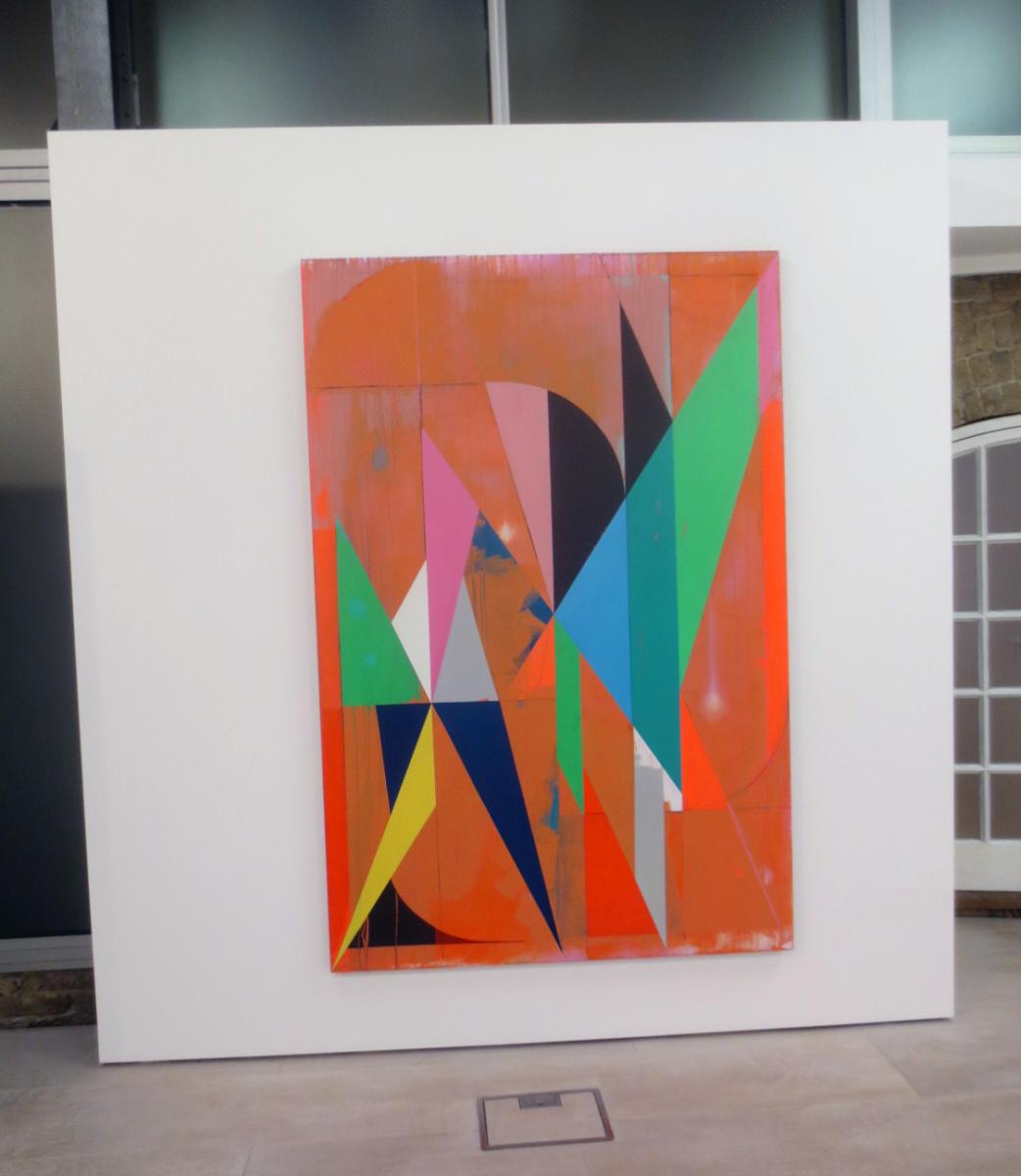
Jaime Gili 'a528'
Including Jaime Gili, who also curated the show, there are nine artists. There is a clear interest in the political and historical cultures of the individual countries and these concerns shine through in the works. As the brochure points out: “The exhibition is an experiment to test the depth of the artists’ shared perspective at the confluence between Latin America and Europe.”
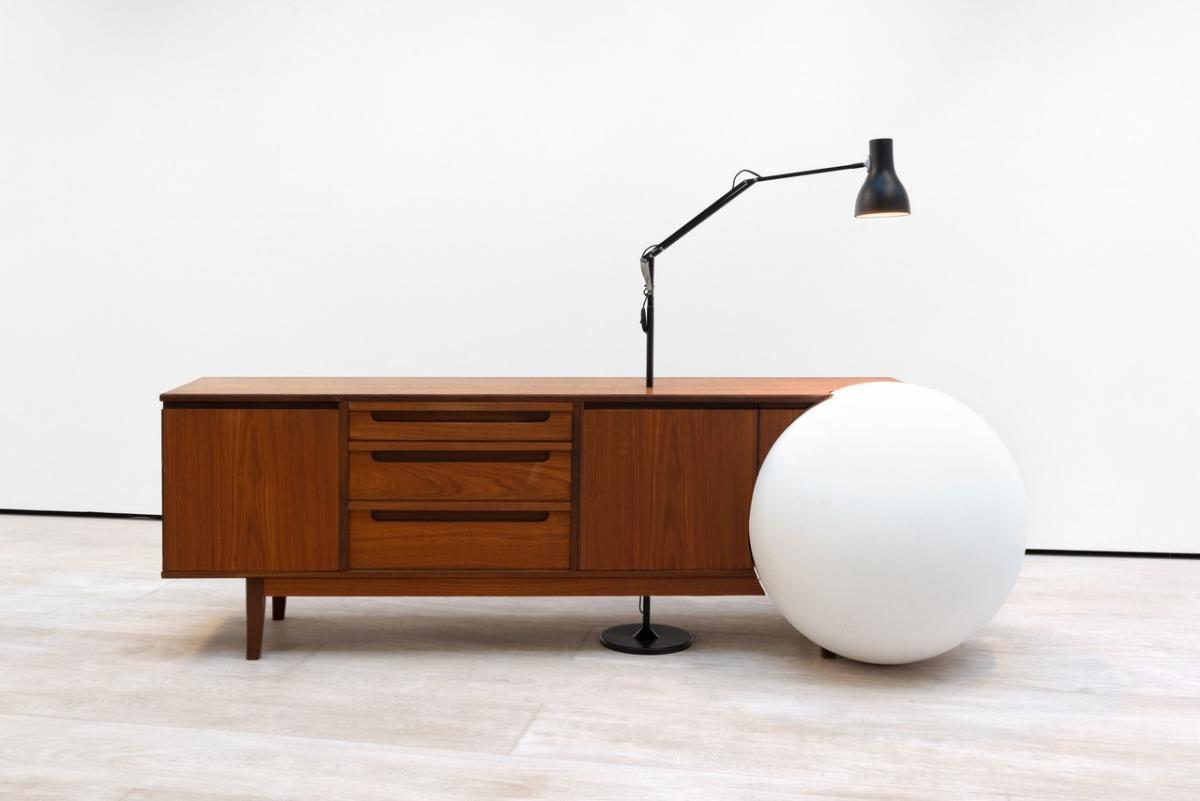
HOST by Martin Cordiano ( Argentine)
Cecilia: - “There are two Argentinians who, for me, are the most Borgesian. This piece is a sculpture, [a large sideboard with a huge sphere that is attached to one corner as if organically connected or growing from it]. It is called ‘HOST’ and evokes this idea of being in a transitional phase, coming from one country to another, how at first you are a bit of an alien and then, you begin to integrate and fit in…so this piece is by MARTIN CORDIANO. It is an amazing piece, when the lights come off it, you feel something is about to happen. It is quite a powerful work with multiple readings, so I felt it was a very interesting proposition. Likewise, CHINO SORIA, comes from Buenos Aires, Argentina. He worked with a group in Argentina coming out of the 1990s, that was incredibly discursive. His work is about ‘found’ materials. Poetry is at the core of it, because poetry is one of the freest forms of expression within the arts. He is an avid poetry reader and these are objects that were found, that look like they had no purpose but when you put them together, they develop an otherness that makes total sense. He also talks a lot about the precarity of Latin America and how life in Argentina was very much about living from hand-to-mouth, so this implied existing and surviving on discarded materials. He then took this to another form of political reality. He is a Marxist, so he brings it into this wonderfully evocative piece that has multiple narratives.”
The sculpture is extremely delicate, despite the centre being a large strong branch, it has a whimsical and ethereal quality- as if it were surviving on a kiss and a prayer, as people did at the time. It is a very memorable piece of work. It is a sort of 3D Paul Klee. It has a variety of textures and the elements are suggestive and fragile.
CECILIA BONILLA, from Uruguay, has two very different pieces. One is comprised of two photographs using collage effects and elements in a mono- print effect. They are in black & white and evocative of a period , like the 1950s, with beaches, water and femininity. They manipulate the ‘myth of the female’, interesting, as she is a female artist herself. Her second piece is also imaginative and fun. Evoking a sensation of the universe, her thoughts are projected as an array of random glass marbles that are attached to the walls of the entrance like a marble ‘big bang’, which is effective and playful.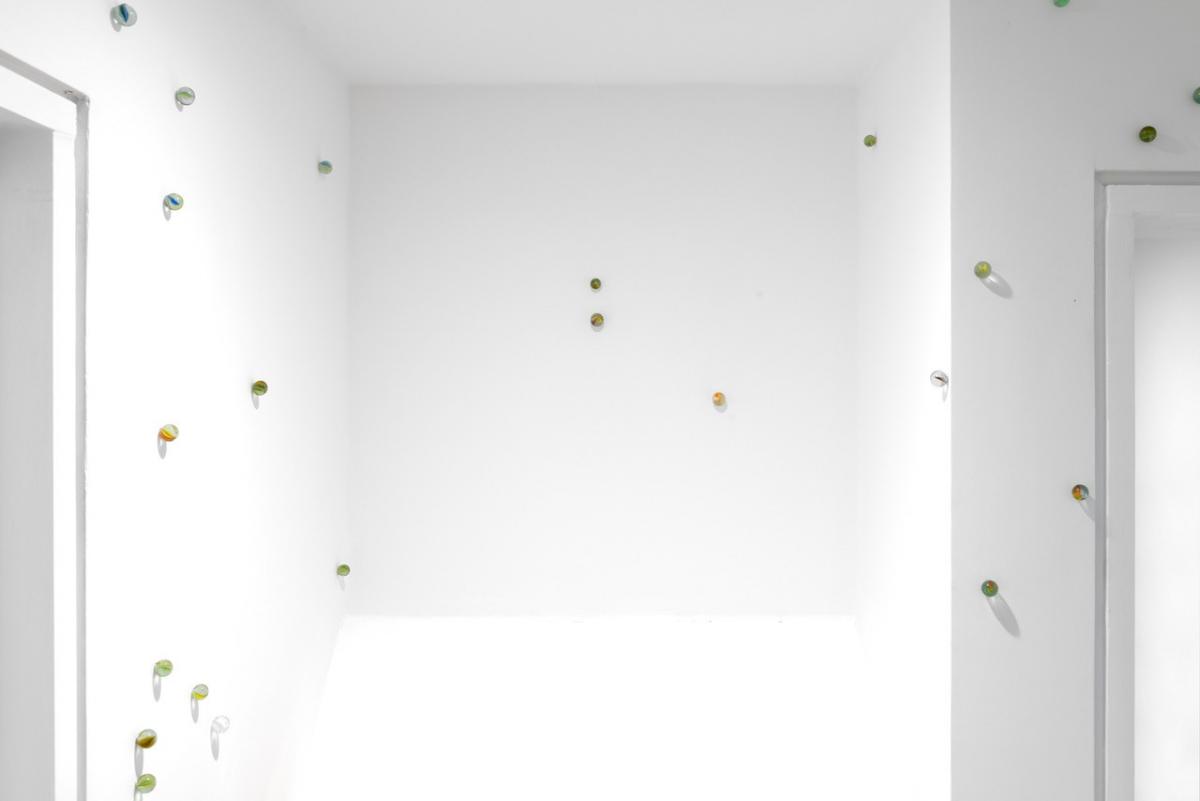
'Glass Marbles' by Cecilia Bonilla
The smallest item in the exhibition has a fascinating inspiration. It is called ‘MIGA DE PAN’ by MANUELA RIBADENEIRA who is from Ecuador. The story behind it relates to one of the largest machines in the world, the Hadron Collider (LHC at CERN). This feat of engineering is a 27 km long particle accelerator. This vast elliptical circumference is buried 175 metres below the French -Swiss Border near Geneva. Vital for research into Quantum mechanics, this huge scientific electro-magnetic particle collider has been essential to carry out the complex collisions in the search for the Higgs Boson [or God] particle. The story in question is that this vast and extremely expensive Hadron collider mysteriously and suddenly stopped functioning.
As it was reported: “Sometime on Nov. 3rd 2009, the supercooled magnets in sector 81 of the Large Hadron Collider (LHC), outside Geneva, began to dangerously overheat. Scientists rushed to diagnose the problem, since the particle accelerator has to maintain a temperature colder than deep space in order to work. The culprit? A bit of baguette!” In effect, the offending element was no more than a tiny breadcrumb! An interesting tale behind Ribadeneira’s tiny bronze sculpture! As Cecilia described it: “This is the smallest object in the show but equally the most powerful!”
PATRICIA DOMÍNGUES from Chile started out as a botanist, and, when she eventually became an artist, she began looking at pre-Colombian culture and observing how the Latin American landscape was being changed by globalization, with three works including ‘Monsters of Levitation’ and ‘Shapeshifting Lines’: -
“[Her work] is a mesh of all these different times and cultures that come together in a post- culture. She thinks about the future by looking at the past and these ‘drones with a Third Eye’. She’s a very interesting artist. Although she doesn’t actually live here, she has recently been at a residency at Gasworks and now, she is about to open a show at the Wellcome Collection. Jaime Gili, the curator artist, decided that we should include her as she is now part of this group of artists.”
Two artists have found very different solutions in their comments about colonialization and the violence perpetrated on society. LUCIA PIZZANI, in “Todopoderosa” (All powerful), took ex-rays of a serpent’s skin, looking at it from the point of view of transformation, as well as relating to powerful, gruesome, ancient traditional Inca rites. The changing of skin is such a powerful metaphor: -
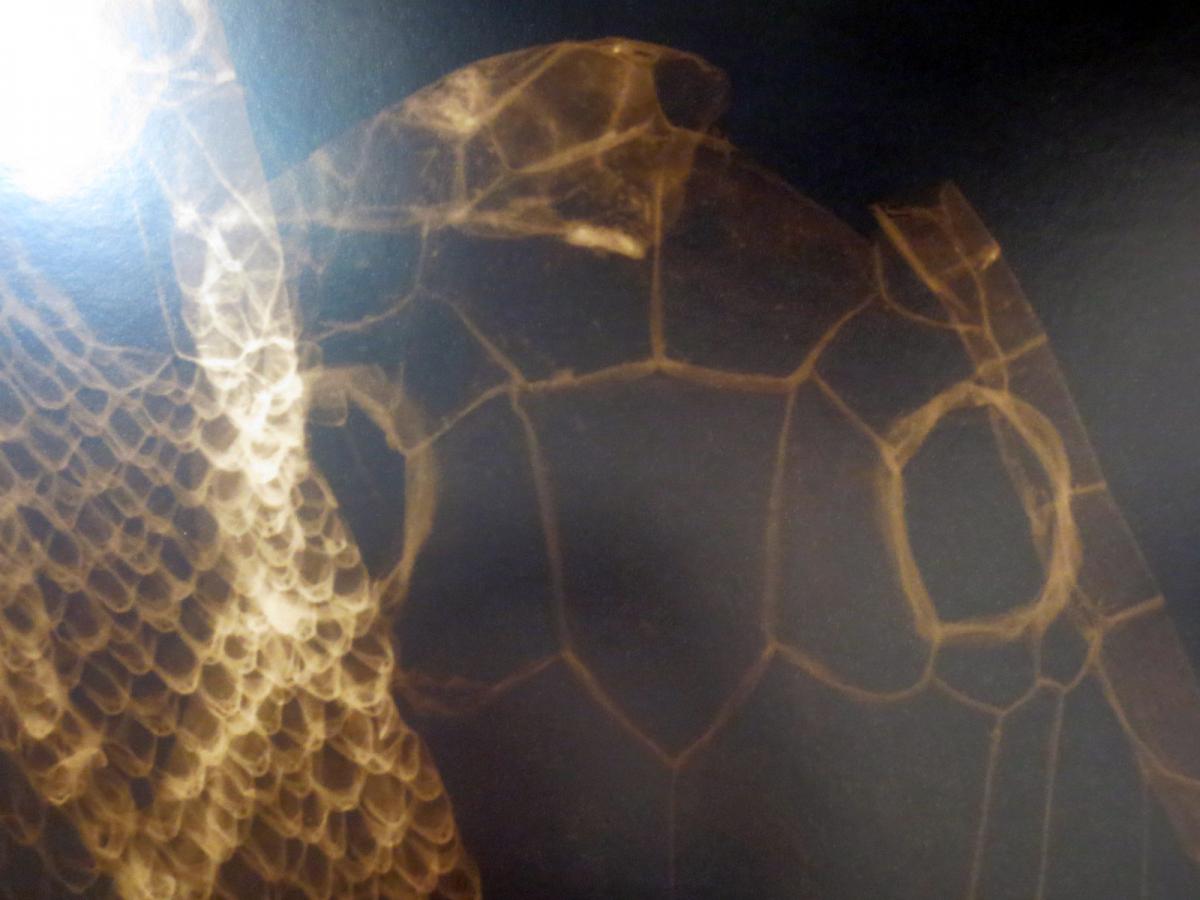
'Todopoderosa' by Lucia Pizzani
“One of the things that the Incas did, when they conquered new lands and tribes, they would take over their skin and actually ‘put their skin on’ [like a mask]. This is really gruesome! It really bothered Pizzani, so she started researching the issue and it ended up in this beautiful exercise, using a serpent, which is such a wonderful metaphor for the changing of the skin.”
On the other hand, conceptual Peruvian artist LIZI SÁNCHEZ, also looked into the past, in particular at colonialism and how it works through language, using the word ‘Ananá’ or ‘Pineapple’ drawn onto 5 fragile sheets of carbon paper: -
“ ‘NANA’ touches on the problems of colonialism, of language and interpretation, but equally everyone is thinking about this idea that is coming from one land into another and how the synthesis of all these cultures come together to create an identity that is constantly shifting.”
Another of the contributors to this show, is Brazilian artist ALEXANDRE CANONICO, who was the runner up in the VIA Prize from Dec 2019. (see https://www.latinolife.co.uk/articles/arts-prize-2019). Having studied Architecture and Urbanism in São Paulo, he was influenced by the strong presence of constructivism in Brazil, led largely by Oscar Niemeyer, the key architect of Brasilia. These influences have inspired his work since then, so he uses an architectural language to produce works and relief sculptures that explore a transition between the spatial representation and physical expression of the objects. Normally, he kept his works to a monochrome palette, with limited use of colour. This vibrant and colourful new work: “BUT” is taking him in a new direction that is more playful, fresh and has a greater fluidity than some of his earlier works.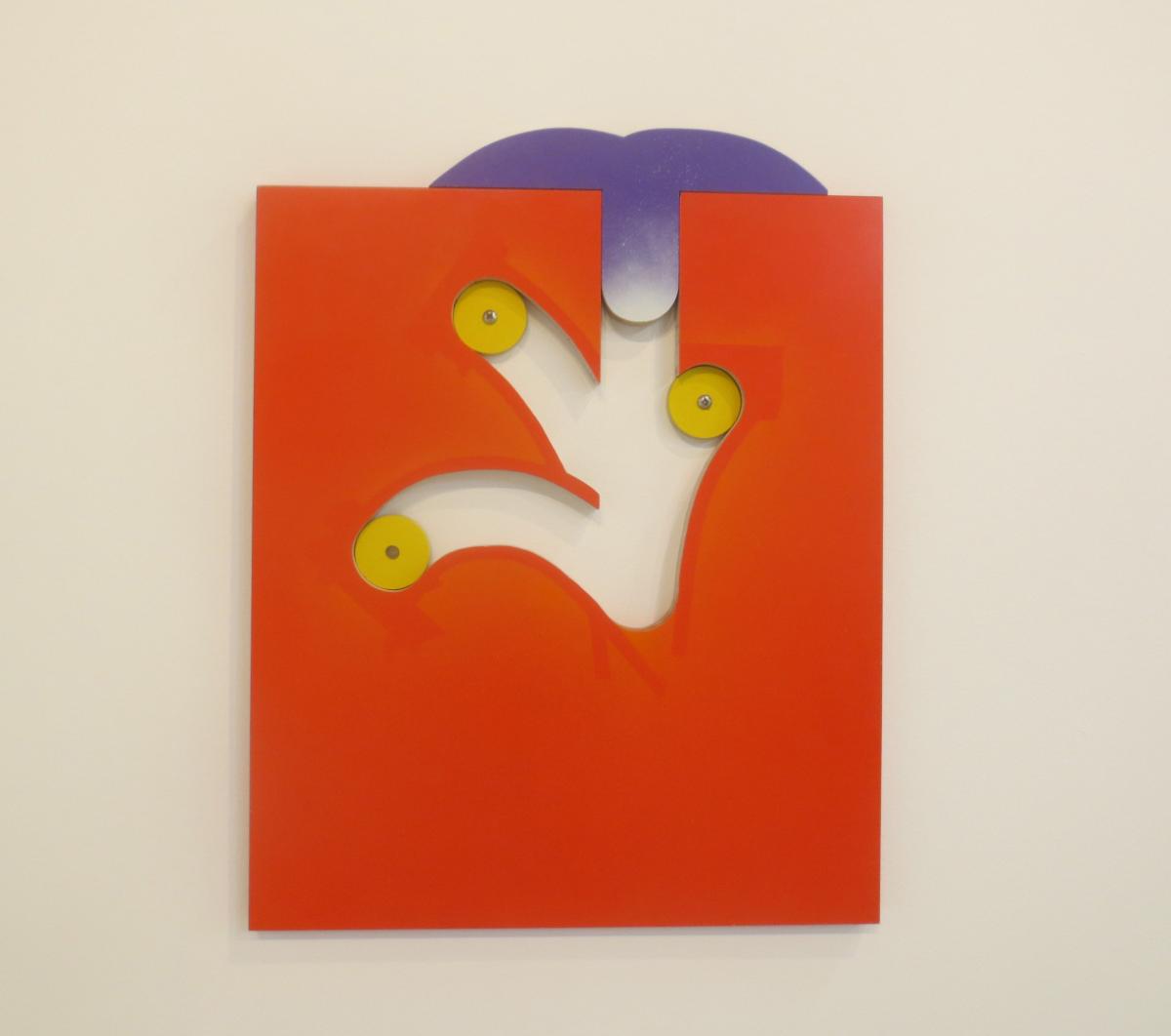
'BUT' by Alexandre Canonico
The Gallery is also showing a series of stunning photographs by PAZ ERRÁZURIZ called ‘Próceres’ (‘National Heroes’) taken at a foundry in Chile some years ago, that have lost none of their relevance: -
“Here… old statues are stored and many are broken-up and re-smelted to make new ones. It was during the Pinochet regime period so she went and took a series of photographs in black and white. The regime wanted to produce new sculptures so they reused the metal from the old rejected statues. A new name and a new polish and it’s the same thing all over again. It’s the story of what is going on even today. Because of what is happening in Chile now, Paz decided to bring out the photographs she had taken many years ago and make them into this body of work.”
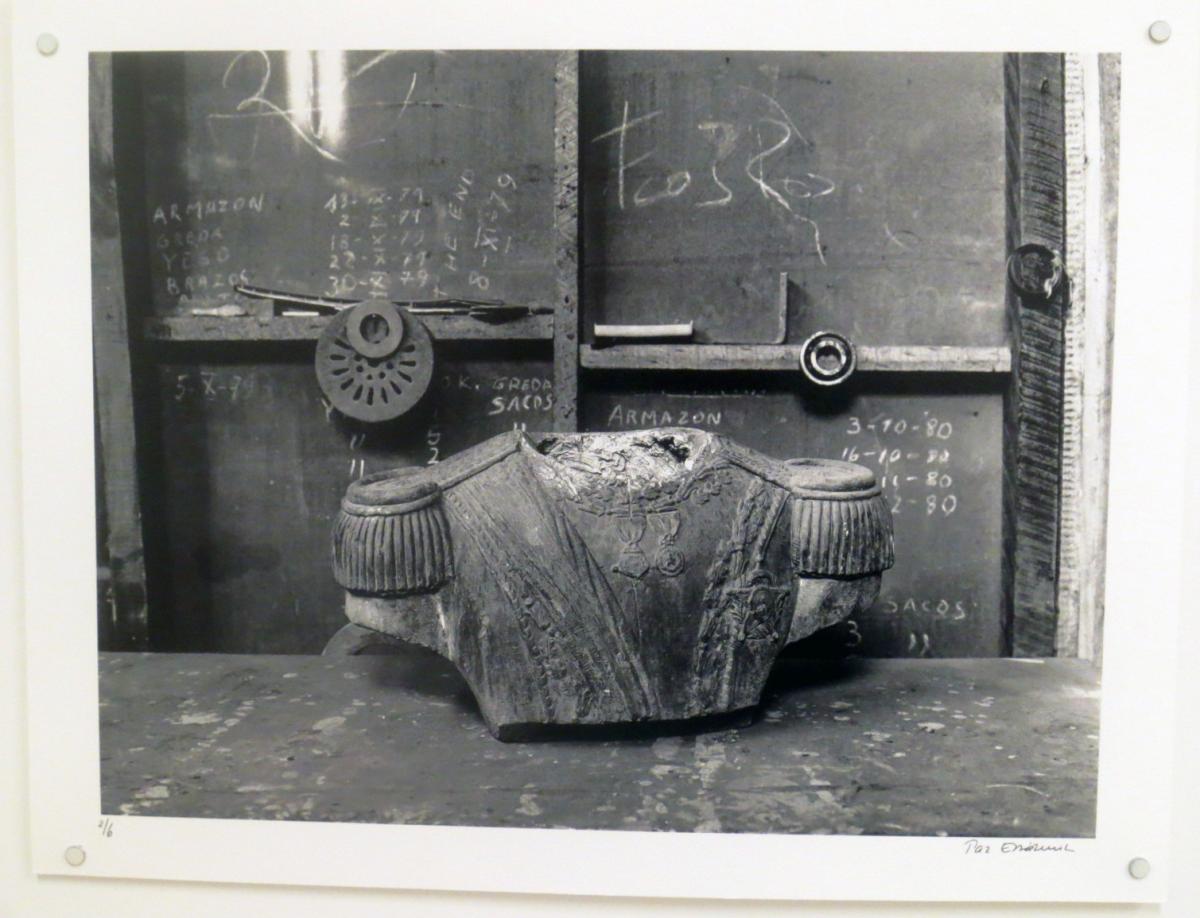
'National Heroes' by Paz Errázuriz
These powerful photographic images recognize how the ‘victors’ manipulate history. There in this Chilean foundry, national heroes of the past have been smelted down, broken up, to be recreated into new ‘sacred’ heroes. In the accompanying article (written by Rebecca Jagoe) she limits this activity to “… fascist and far-right regimes [that] have deployed historical and cultural ‘negationism’ as a means of forwarding propaganda, a false justification for state- enacted violence and genocide.” However, I totally disagree that this only happens in these regimes, it happens in ‘all totalitarian regimes’, being, sadly, definitely not restricted to right-wing regimes, but equally prevalent in left-wing regimes, like those run by Chairman Mao or Stalin to mention but two.
The artists were invited to contribute a book or item that had moved them, these are exhibited in a cosy corner including a musical contribution that can be enjoyed through headphones.
The two shows of CONTAGIO (Contagion) and 'NATIONAL HEROES' by PAZ ERRÁZURIZ will be on until March 6th 2020 at the Cecilia Brunson Gallery.
Cecilia Brunson Projects, 2G Royal Oak Yard, Bermondsey Street, SE1 3GD / Open 10am- 6pm, or at other times by appointment.
Ceciliabrundonprojects.com / @CeciliaBrunsonProjects




